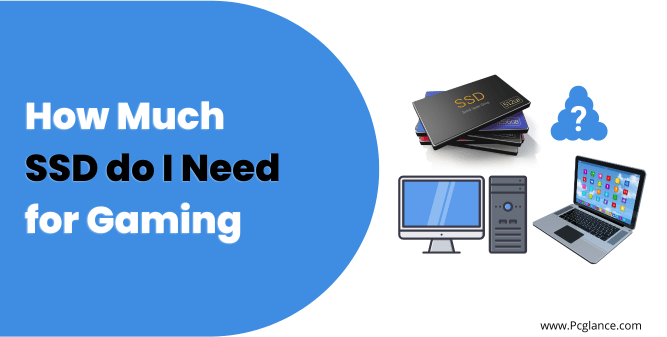Solid-state drives (SSDs) have become increasingly popular in the gaming community due to their faster performance and improved loading times compared to traditional hard disk drives (HDDs).
SSDs are one of the best upgrades you can make for your gaming PC or gaming Laptop. They offer faster loading times, smoother performance, and more durability, but how much SSD do you actually need for gaming? Is there a minimum or maximum size that you should aim for?
In this guide, I will help gamers determine how much SSD storage they need for gaming, taking into account their gaming habits and budget. I will also provide some tips and recommendations on how to choose the right SSD for your gaming needs. So let’s get started!
Understanding the role of SSD in gaming
Before I can answer the question on the specific storage capacity you need for gaming, it is important to understand the role that SSD plays in enhancing your gaming experience.
SSDs bring a significant improvement to gaming in terms of faster boot times, reduced loading screens, and improved overall performance. This is primarily due to their ability to access and transfer data at incredibly high speeds, providing quick access to game files and resources.
With an SSD, you can expect seamless transitions between game levels, reduced stuttering, and improved responsiveness. This is particularly beneficial in fast-paced games where split-second reactions can make a significant difference.
In addition to the performance benefits, SSDs also offer increased durability and reliability compared to traditional HDDs, as they do not have any moving parts. This makes them less prone to failure and ideal for long gaming sessions.
Now that we understand the advantages of SSDs in gaming, let’s move on to the next section which is the key section of this article:
How Much GB SSD do I Need for Gaming?
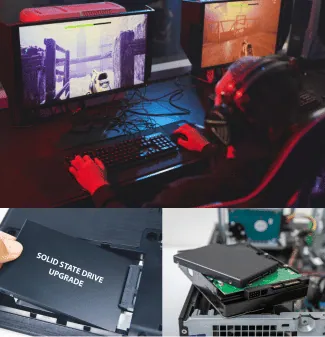
The amount of SSD storage you need for gaming either on your pc or laptop depends on several factors, such as:
- How many games you want to install and play at the same time
- How large are the games you want to play
- How often do you update or uninstall your games
- How much space do you need for other files and programs on your PC
Generally speaking, the more games you have, the larger they are, and the more frequently you change them, the more SSD space you will need. However, there is no definitive answer to how much SSD you need for gaming, as different gamers have different preferences and habits.
Therefore, the best way to determine how much SSD you need for gaming is to estimate your current and future storage needs and choose an SSD that can accommodate them. To give you an idea, here are some examples of how many popular games you can fit on different SSD sizes.
| SSD Size | Number of Games | Example Games | Game Sizes (GB) |
|---|---|---|---|
| 128 GB | 2 to 3 | Among Us, Minecraft, Fortnite | 2, 2, 30 |
| 256 GB | 4 to 6 | Call of Duty: Warzone, Cyberpunk 2077, GTA V | 175, 70, 94 |
| 512 GB | 8 to 12 | Red Dead Redemption 2, Assassin’s Creed: Valhalla, The Witcher 3 | 150, 50, 40 |
| 1 TB | 16 to 24 | Star Citizen, Flight Simulator 2023, Half-Life 3 | 100, 150, 60 |
| 2 TB | 32 or more | All of the above and more | Varies |
As you can see, the number of games you can fit on your SSD depends on the size of the games. Some games are smaller and take up less space while some games are larger and take up more space.
Some games also have updates and expansions that can increase their size over time. Therefore, you should always check the size of the games you want to play before buying an SSD.
Also Read: Can You Add External RAM to a Laptop
Different storage Capacities of SSDs
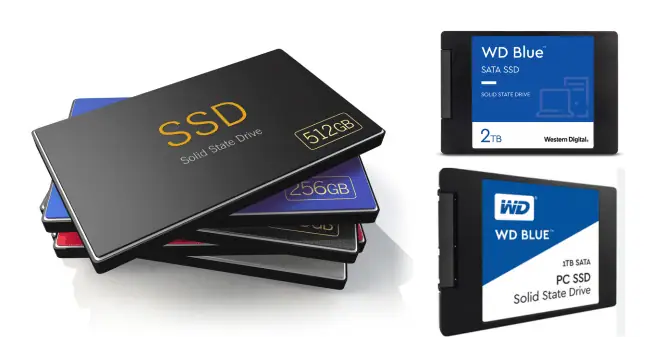
Above was just a rough idea and to dive you deep into this question so you can find the answer for your question, I will list different SSD storages capacities, so you can see what you can do with different sizes and which one is most suitable for you
128GB SSD:
This is the smallest SSD size that you can find on the market, and it is not recommended for gaming. A 128GB SSD can only hold a few games, and you will quickly run out of space if you want to play more.
Moreover, a 128GB SSD will have less performance and lifespan than a larger SSD, as it will have less free space and more write cycles. Therefore, you should avoid a 128GB SSD for gaming, unless you only play one or two small games and nothing else.
256GB SSD:
This is the minimum SSD size that you should consider for gaming. A 256GB SSD can hold about 4 to 6 games, depending on their size. This is enough for casual gamers who only play a few games at a time and don’t mind uninstalling or moving them to another drive when they are done.
However, a 256GB SSD may not be enough for hardcore gamers who play a lot of games and want to keep them all on their SSD for faster loading.
Also, a 256GB SSD may not leave much space for other files and programs on your PC, so you may need to use an external HDD or cloud storage for backup.
512GB SSD:
This is the most common and recommended SSD size for gaming. A 512GB SSD can hold about 8 to 12 games, which is enough for most gamers who play a variety of games and genres.
A 512GB SSD also gives you more flexibility and convenience, as you don’t have to worry about running out of space or deleting your games too often.
Plus, a 512GB SSD will have better performance and longevity than a smaller SSD, as it will have more free space and less write cycles. Therefore, a 512GB SSD is a good balance between capacity, performance, and price for gaming.
1TB SSD:
This is the optimal SSD size for gaming, especially for gamers who play a lot of large and demanding games. A 1TB SSD can hold about 16 to 24 games, which is more than enough for most gamers who want to have all their favorite games on their SSD for the best gaming experience.
A 1TB SSD also gives you plenty of space for other files and programs on your PC, as well as for future game updates and expansions.
Moreover, a 1TB SSD will have the best performance and lifespan of all SSD sizes, as it will have the most free space and the least write cycles. Therefore, a 1TB SSD is the ideal choice for gamers who want the ultimate SSD for gaming.
2TB SSD:
This is the maximum SSD size that you can find on the market and it is only for gamers who have an unlimited budget and storage needs. A 2TB SSD can hold about 32 to 48 games or more which is way more than any gamer would ever need.
However, a 2TB SSD is very expensive and may not be worth the extra cost, as you may not notice much difference in performance or lifespan compared to a 1TB SSD. Therefore, a 2TB SSD is only for gamers who want to have the biggest SSD and to store all of their favourite games.
How to Choose the Right SSD for Gaming?
Now that you have an idea of how much SSD you need for gaming, the next step is to choose the right SSD for gaming. There are many types and models of SSDs on the market, and they vary in terms of performance, features, compatibility, and price.
Therefore, you need to consider the following factors when choosing the right SSD for gaming:
Interface:
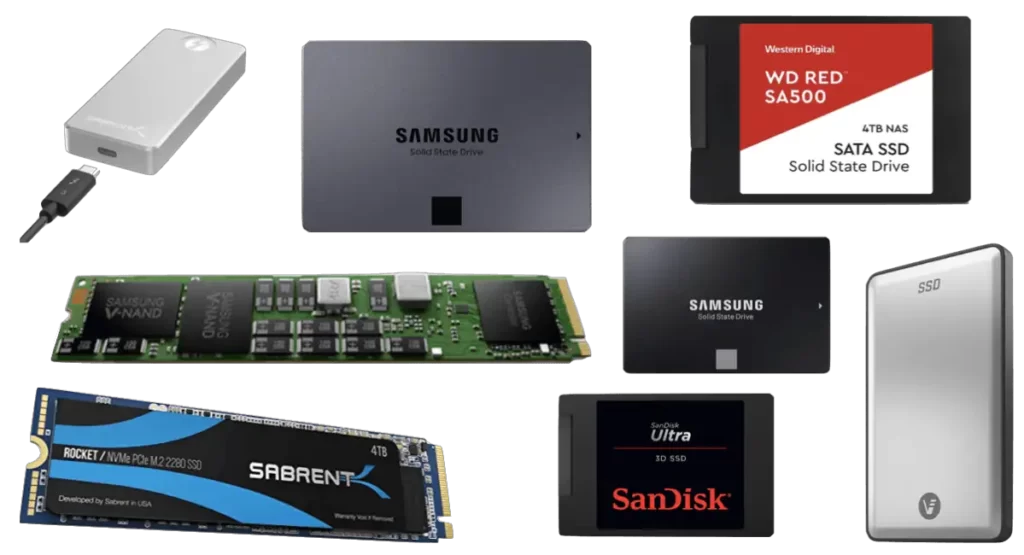
This is the connection type between your SSD and your PC/laptop. There are two kinds of interfaces: SATA and NVMe. SATA is older and slower, but more common. NVMe is newer and faster, but more expensive and may not work with some older PCs. You need to check if your PC can use NVMe before you buy it.
Form factor:
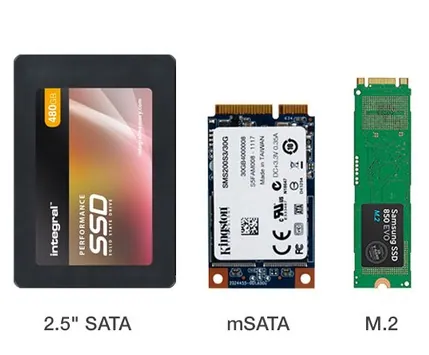
This is the physical shape and size of your SSD. There are two main types of form factors for SSDs: 2.5-inch and M.2. 2.5-inch SSDs are the same size and shape as HDDs, and they can fit in any PC case that has a 2.5-inch drive bay but they might not fit in a gaming laptop.
M.2 SSDs are much smaller and thinner than 2.5-inch SSDs and they can fit in any motherboard that has an M.2 slot. M.2 SSDs are more convenient and space-saving than 2.5-inch SSDs, as they don’t require any cables or brackets to install.
Performance:
This is how fast and efficient your SSD is. Performance is measured by read and write speeds, random and sequential access and endurance and reliability. NVMe SSDs have much higher performance than SATA SSDs, but they also cost more. So choose an SSD that meets your gaming needs and budget.
Here is a table that compares the performance of some popular SSD models in 2023:
| Model | Interface | Form Factor | Capacity | Read Speed | Write Speed | Random Access | Sequential Access | Endurance | Reliability | Price |
|---|---|---|---|---|---|---|---|---|---|---|
| Samsung 980 Pro | NVMe | M.2 | 1TB | 7000 MB/s | 5000 MB/s | 1000000 IOPS | 5000 MB/s | 600 TB | 1.2 DWPD | $199 |
| WD Black SN850 | NVMe | M.2 | 1TB | 7000 MB/s | 5300 MB/s | 1000000 IOPS | 5300 MB/s | 600 TB | 1.2 DWPD | $229 |
| Crucial P5 | NVMe | M.2 | 1TB | 3400 MB/s | 3000 MB/s | 430000 IOPS | 3000 MB/s | 600 TB | 1.2 DWPD | $129 |
| Samsung 870 QVO | SATA | 2.5-inch | 1TB | 560 MB/s | 530 MB/s | 98000 IOPS | 530 MB/s | 360 TB | 0.7 DWPD | $99 |
| WD Blue 3D NAND | SATA | 2.5-inch | 1TB | 560 MB/s | 530 MB/s | 95000 IOPS | 530 MB/s | 400 TB | 0.8 DWPD | $89 |
| Crucial MX500 | SATA | 2.5-inch | 1TB | 560 MB/s | 510 MB/s | 95000 IOPS | 510 MB/s | 360 TB | 0.7 DWPD | $84 |
You May Like to Read:
15 Common laptop problems and solutions
Is 8gb Ram Enough for MacBook Pro
Best practices for maximizing SSD performance in gaming
While the capacity of your SSD is important, maximizing its performance is equally crucial for an optimal gaming experience. Here are some best practices to help you get the most out of your SSD storage:
1. Regularly update your SSD’s firmware: Manufacturers often release firmware updates to improve performance and fix any bugs or compatibility issues. Make it a habit to check for firmware updates and apply them accordingly.
2. Enable TRIM: TRIM is a feature that allows your SSD to efficiently manage and delete unused data. Enabling TRIM ensures that your SSD stays in top shape and maintains optimal performance over time. Check your operating system settings to make sure TRIM is enabled.
3. Avoid overfilling your SSD: SSDs perform best when they have some free space available. Aim to keep at least 10-20% of the total capacity free to allow for efficient performance and maintenance.
4. Disable unnecessary background tasks: Some programs and services can use your SSD in the background, causing unnecessary wear and reducing gaming performance. Disable any non-essential tasks that might be running to free up resources for gaming.
By following these best practices, you can ensure that your SSD not only provides sufficient storage but also delivers high-performance gaming for years to come.
FAQ Section
Here are some frequently asked questions and answers about how much SSDs should be good for gaming
Do SSDs improve FPS (frames per second) in games?
No, SSDs do not directly improve FPS in games, as FPS depends on your CPU, GPU, RAM, and monitor. However, SSDs can indirectly improve FPS in games, as they can reduce stuttering, lagging, and loading times, which can affect your FPS.
Therefore, SSDs can improve your overall gaming experience and performance, but not your FPS.
Can I use a smaller SSD for the OS and a larger HDD for games?
Yes, you can. It’s a common strategy to use a smaller SSD (e.g., 250GB or 500GB) for the operating system and critical applications, and pair it with a larger HDD for additional game storage.
What about NVMe SSDs for gaming? Are they worth it?
NVMe SSDs offer faster data transfer speeds compared to SATA SSDs. While they can enhance gaming performance, the difference may not be as noticeable during gameplay. Consider NVMe for tasks like large file transfers or video editing.
How much free space should I leave on my SSD for gaming?
You should leave at least 10% to 20% of free space on your SSD for gaming, as this can help your SSD maintain its performance and lifespan. If your SSD is too full, it can slow down your SSD, reduce its endurance and reliability, and cause errors and crashes.
Therefore, you should regularly check your SSDs free space and delete or move any unnecessary files or programs.
Final Verdict
As we come to the end of this blog, its clear that there is no one-size-fits-all answer to how much SSD you need for gaming. It ultimately comes down to finding the right balance between speed and capacity to meet your specific gaming needs.
Investing in a larger capacity SSD certainly offers its advantages, allowing for more games and faster load times. However, it’s crucial to remember that the larger the capacity, the higher the cost. If you are on a budget or have limited storage needs, a smaller capacity SSD may be sufficient.
It’s also worth considering whether an SSD is your sole storage solution or if you are using it in combination with traditional hard drives. By having an SSD for your operating system and frequently played games, and using a hard drive for less frequently used files, you can strike a balance between speed and capacity while keeping costs down.
Ultimately, the ideal amount of SSD storage for gaming will depend on your personal preferences, budget, and storage requirements. Consider the games you are currently playing or plan to play, factor in the storage size requirements of those games, and invest accordingly.
By considering these factors and following the optimization techniques discussed earlier, you can make an informed decision and ensure a more enjoyable gaming experience.
I hope this blog has provided valuable insights and helped you make a more informed decision when it comes to upgrading your gaming storage.

Hamza Afridi is the founder and editor of PC Glance, a website that covers computers, laptops, and technology. He is a tech enthusiast and a computer geek who loves to share his insights and help his readers make smart choices when buying tech gadgets or laptops. He is always curious and updated about the latest tech trends.

